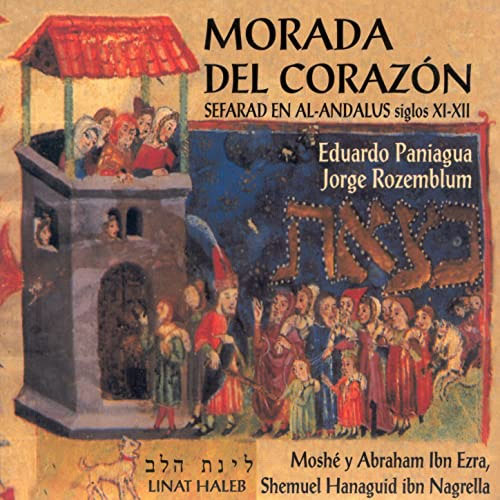Madrid, Spain – There is a new release by Eduardo Paniagua, called Morada Del Corazón (The Heart’s Abode), which features Jorge Rozemblum. This CD released by Pneuma Records focuses on poems from the Golden Age of the Sepharad in Al-Andalus, with Sephardic melodies and contrafactum pieces from the Andalusian-Maghrebian music of the Sufi brotherhoods and from the Moroccan and Garnati nawbat.
The poems, written by Moshe and Abraham Ibn Ezra, and Shemuel Hanaguid ibn Nagrella, are played with Medieval and North African traditional instruments such as qanun (Arabic zither), Arabic lutes, fidula (ancient viola), citola (Medieval guitar), flutes and percussion (dumbek, darbuqqa, riqq, tar, sistrum), and is sung in Hebrew.
Overview
In 10th century Al-Andalus, and especially in the city of Cordoba, there was a reawakening to science and the humanities among the Jews. Cordoba, rival to Baghdad, became “the house of science” (dar al-ulum) famous in all of Europe.
The Jews from Al-Andalus had access to this knowledge and for the first time wrote about science, grammar and philosophy. They began to write poetry for its linguistic beauty, turning to subjects such as nature and the delight and entertainment of the senses rather than just religious purposes.
Although generally inspired by religious themes (piyyutím), music was also influenced by the new profane poems that flowed from the pens of these great men of the Golden Age of Jewish-Andalusian poetry. In spite of the fact that the melodies of the time do not survive today (10th-13th centuries), we know through the literature of the time that contrafactum was common practice at the time, that is the use of a popular melody from a different source (Muslim or Christian) as a base to sing the texts in Hebrew. This external influence is even encountered in the adoption of musical forms such as the suite of Arabic poems of the nawba, transformed in the baqqashot that the Sephardic Jews still sing on the morning of certain celebrations.
The musicians used emotive melodies from the Andalusian-Maghrebian tradition, both from the Sufi brotherhoods and the aristocratic music of the nawbat of Morocco and the Garnati tradition from Algeria. They also realized that some melodies from the Mudejar repertoire of the cantigas of Alfonso X the Wise, could also have been contrafactum of songs from former times.
Index
1 A Hanukkah Prayer. Traditional Sephardic.
2 The Dedication of the Temple. Psalm 30. Anonymous from Salonica.
3 I shall meditate on the Torah. (Instrumental)
4 “Ke eshmerah shabbat”, If I observe the Sabbath. Abraham Ibn Ezra (1089-1167).
5 The Conversion of the Jew. (Instrumental). Alfonso X the Wise. (1221-1284).
6 “Me techila asa”. God in the Beginning. Shemuel Hanaguid ibn Nagrella
(993-1055).
7 The Sacred Shabbat. (Instrumental). Jewry of the Ottoman region.
8 “Esh Ahabeem”. Fire of Passion. Shemuel Hanaguid ibn Nagrella (993-1055).
9 Rest on Shabbat. (Instrumental). Yemenite melody.
10 “Asher lo yam”. Yours are the Seas. Shemuel Hanaguid ibn Nagrella.
11″‘Al ma’atzabee” My Heart Aches. Moshe ibn Ezra (h.1055-h.1135).
12 “El Ne-eratz”. Oh, Terrible God. Shemuel Hanaguid ibn Nagrella.
13 “Ketanot pasim”. Striped Tunic. Moshe ibn Ezra (h.1055-h.1135).


